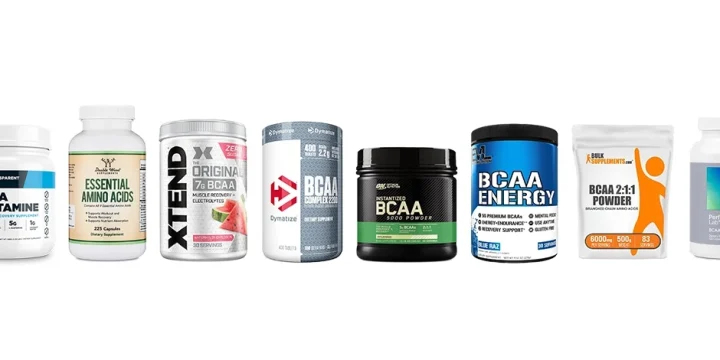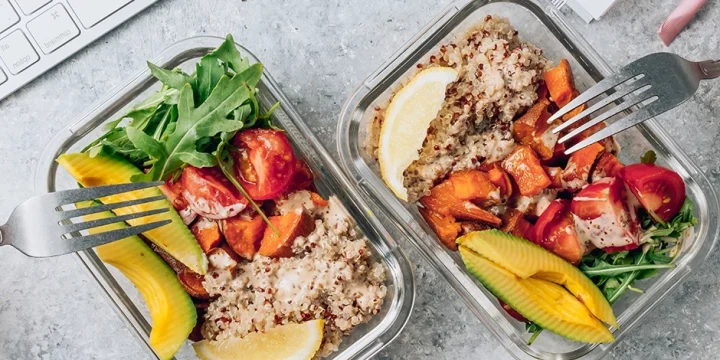Speaking as a fitness coach with a decade of experience, the shoulder, and back muscle groups are crucial for an upper body physique that really stands out.
So, to help our clients and readers, we’ve decided to create this article to show you how to approach a proper back and shoulder workout.
To make a full-proof article, we did some research and reached out to physical therapists and colleagues in the fitness industry. Here’s what we found.
Quick Summary
- Some of the most effective exercises for the back and shoulders include barbell bent-over rows, pull-ups, lat pulldowns, lateral raises, and dumbbell front raises.
- Training the shoulder muscles alongside the back muscle group is optimal, as it helps prevent overtraining, reduces the risk of strain, and promotes a balanced approach.
- Research from the National Institute of Health indicates that overtraining the muscles can lead to Rhabdomyolysis, a condition in which skeletal muscle rapidly breaks down and is damaged.
- As a fitness trainer, I often suggest clients pair shoulder muscle workouts with another major muscle group and supplement their routines with protein supplements to enhance recovery.
Best Back and Shoulders Workout

Below is a list of the most effective back and shoulder exercises.
1. Barbell Bent Over Rows
Also known as the barbell high row, this exercise targets the back, shoulder, and arm muscles, emphasizing back development. It can be performed with dumbbells, barbells, or a machine.
Here’s how to do the barbell bent over row:
- Hold a barbell with an overhand grip, hands slightly shoulder-width apart.
- Maintain a slightly bent position in your legs, a straight back, and a slightly forward-bent upper body.
- Row the weights upward to the lower part of your chest, pause, and then return to the starting position.
2. Lat Pull-down
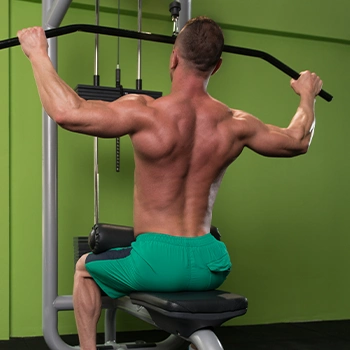
This cable machine exercise primarily targets the latissimus dorsi muscles in the back but also involves the shoulders and arms.
Here’s how to do the lat pull-down:
- Load weights onto the lat pull-down machine.
- Sit in front of the machine with your thighs under the leg support, keeping your chest up.
- Grab the bar with palms facing away, slightly wider than shoulder width.
- Pull the bar down to touch your upper chest or below your chin, then slowly return to full arm extension.
3. Renegade Rows
The renegade row effectively targets multiple muscle groups, including the shoulders, chest, and core, in addition to its primary focus on the back muscles. To perform this workout properly, you will need to incorporate weights.
Here’s how to do the renegade row:
- Assume a plank position for this workout, ensuring that you position the dumbbells shoulder-width apart on the floor beside your hands.
- While maintaining a plank, engage your core and row one dumbbell to your hip while shifting your weight to the opposite side.
- Lower the dumbbell and then repeat the same movement with the other dumbbell.
4. Pull-ups
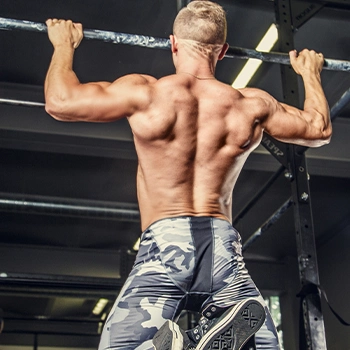
Pull-ups are challenging bodyweight exercises that focus on the chest, arms, and back, making them particularly demanding for novice trainees. As a fitness trainer, I suggest utilizing a resistance band connected to a pull-up bar for a more manageable workout.
Here’s how to do a pull-up:
- Begin by extending your arms overhead and stepping up to grab a pull-up bar with an overhand grip that is slightly wider than shoulder width.
- Allow your legs to lift off the floor, keeping them in a hanging position.
- Engage your back muscles and bend your elbows, pulling yourself upward until your chin is above the bar.
- Upon reaching the peak of the pull-up, gradually lower yourself back down.
- Repeat the entire process for additional repetitions.
“Pull-ups activate muscle groups including back, chest, shoulders, arms, and core – providing an all-over upper body workout.
- Faisal Abdalla, Fitness Coach
5. Romanian Deadlift
The Romanian deadlift is a variation of the traditional deadlift workout. Its main target is the lower back, although it also works your lower body as well.
Here’s how to do it:
- Start in a standing position with a barbell, feet hip-width apart, chest up.
- With your upper back retracted and shoulder blades squeezed, bend your knees slightly and hinge at the hips till the barbell goes below the knees.
- Upon reaching a low point, pause and hinge at your hips to return back to your start point.
6. Superman
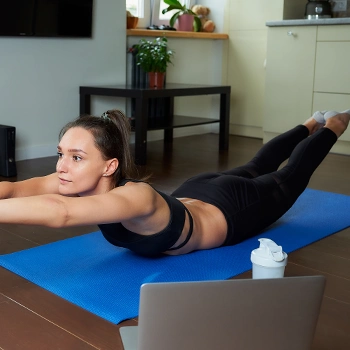
As per the National Institute of Health, the Superman workout effectively targets the lower back muscles while also engaging the upper back, glutes, hamstrings, abdominal muscles, and shoulders [1].
Here’s how to do superman exercises:
- Begin by lying facedown on the floor with your legs extended behind you, arms in front, and palms on the floor.
- Engage your lower back, glutes, core, and shoulder blades as you lift both your upper and lower body off the ground, ensuring your neck is aligned with your spine.
- Hold the lifted position for 1-2 seconds before lowering back down.
- Repeat the exercise.
7. Shrugs
Shrugs are a key exercise for a strong trapezius, working the muscles in the neck, shoulders, and upper arms. This simple movement is effective with or without weights, but using dumbbells or a barbell is particularly beneficial for strength, making it an ideal finisher for a back workout.
How to perform a shrug:
- Stand upright with weights in your hands, arms straight, and extended by your sides.
- Engage your core and lift your shoulders towards your ears to activate your traps.
- Hold the top position for a second, then relax your shoulders back to the starting point.
8. Overhead Press
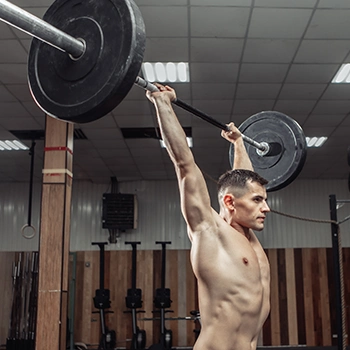
The overhead press is a versatile exercise targeting all three deltoid muscle heads for robust shoulder development, while also engaging the triceps, chest, and upper traps. It can be performed with a barbell, dumbbell, or a smith machine.
Here’s how to do it:
- Grip the bar slightly wider than shoulder-width apart.
- Engage your core muscles to unrack the bar, allowing it to rest against your delts as you step back from the rack.
- Press the bar up until your arms are fully extended, making sure not to use your leg drive for momentum.
- Once at the top, slowly lower the bar back to your shoulders.
9. Dumbbell Front Raise
This upper-body exercise targets shoulders, upper chest, upper back, and arms, emphasizing muscle isolation. Use manageable weights to avoid overloading and choose between dumbbells or a barbell for the workout.
Here’s how to do it with a dumbbell:
- Hold a pair of dumbbells with an overhand grip in front of your hips.
- Now, slowly lift the dumbbells with straight arms till they reach shoulder height.
- Once they reach shoulder height, lower them with control back to your starting position.
10. Dumbbell Lateral Raise
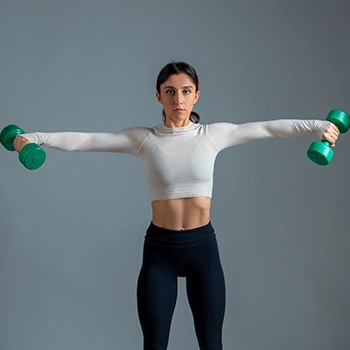
This exercise isolates side delts, enhancing shoulder width for muscular shoulders. Choose a dumbbell that challenges you without compromising form, avoiding momentum to prevent unintended trap engagement.
Now, here’s how to do the dumbbell lateral raise:
- Begin by holding a pair of dumbbells, letting them hang by your sides.
- Lift the dumbbells out to your sides until your arms are horizontal.
- Lower the weights slowly and with control.
- Repeat the process.
11. Arnold Press
The Arnold press, named after Arnold Schwarzenegger, is a variation of the overhead press, primarily targeting the front delts while involving the back and upper arms.
How to do the Arnold press:
- Begin in a seated position on a bench, holding a pair of dumbbells in each hand with palms facing your shoulders, as if you've just completed a bicep curl.
- Push the weights overhead until your arms are fully extended, simultaneously rotating your arms so that your palms face you.
- Pause at the top, then slowly lower the weights while reversing the arm rotation back to the starting position.
12. Upright Row
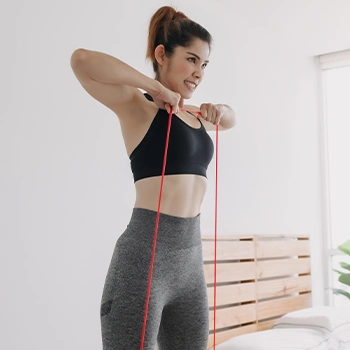
A complete back and shoulder workout includes the upright row, an excellent exercise for the shoulders and upper back. This workout can be done with either dumbbells or a barbell, with dumbbells offering a better range of motion and a barbell allowing for a heavier load.
Here's how to do an upright row with a barbell:
- Stand upright with your feet shoulder-width apart, holding the barbell with a narrow grip just in front of you.
- Engage your core and bend your elbows to pull the barbell up to neck height, keeping it close to your body.
- Pause at neck height, then slowly lower the bar back to the starting position.
13. Bent-Over Rear Delt Flys
The bent-over rear delt is a distinctive exercise that builds muscle in the posterior deltoid, rhomboids, and trapezius in the upper back. The hinge position also strengthens the lower back and stabilizes the rotator cuff muscles.
How to do bent-over rear delt flys:
- Begin by holding a pair of dumbbells in each hand, hinge at your hips, and keep your shoulders down with your chest up.
- With a slight bend in your elbows and controlled movements, raise the weights out to your sides, engaging the upper back.
- Return the dumbbells to the starting position and repeat.
Benefits of Working These Two Together

Here are a few reasons why you should combine a back and shoulder workout.
1. To Prevent Injury
Research from Sage Journals indicates that overtraining the shoulder muscles can lead to injury, so instead of planning a major shoulder day, pairing it with another body part is better to prevent overtraining them [2].
2. Training the Back Primes the Shoulders
The best muscle group to pair a shoulder exercise with is back. See, most back workouts like the rowing motions and reverse flys also train the shoulder to a smaller degree.
“The back and shoulders can be a great pairing due to them having a little bit of overlap in the muscles used. Many upper back exercises have some shoulder muscles used to a smaller degree, and vice versa. So doing back exercises at the start will often act as a primer for the shoulders after.”
- Caine Wilkes, Weightlifting Olympian
In my experience as a fitness trainer, engaging your lats and other back muscles not only works to retract your shoulder blades but also essentially becomes a form of training for your shoulders.
3. Allows You to Train More Than Once a Week
Another benefit of combining a back and shoulder workout is that it allows you to train the muscle groups more than once a week, which is good for muscle hypertrophy.
FAQs
Is Shrugs a Back or Shoulder Workout?
Shrugs are both the back and shoulder workout. The pulling-up movement of the shrug contracts the trapezius muscle, which runs across the shoulder to the middle of the back. It also works the rhomboids, a muscle responsible for shoulder blade mobility.
Should I Do Shoulders or Back First?
You can choose to do either shoulder or back first. However, starting with the one you prioritize is also advisable. If your top goal is building a strong back, then hit it first. And if you prioritize strong shoulders, train them first before a back workout.
What Should I Eat Before a Back and Shoulder Workout?
You should eat a protein-filled meal before a back and shoulder workout. A protein smoothie made of milk, banana, mixed berry, and protein powder can be a great nourishment for optimum muscle gain.
Boost your Workouts with Protein
Back and shoulder exercises such as bent-over rows, overhead presses, shrugs, and upright rows can help you attain an advanced upper-body physique.
However, it takes a lot of discipline and dedication before the results become visible, which affects motivation. That's why I always advise my clients to add a protein powder into the mix.
We’ve tested all the products in these lists, and both our testing data and client feedback shows they are very effective in fast-tracking the results.
References:
- https://www.ncbi.nlm.nih.gov/pmc/articles/PMC6165989/
- https://journals.sagepub.com/doi/10.1177/1941738120931764
About The Author
You May Also Like
